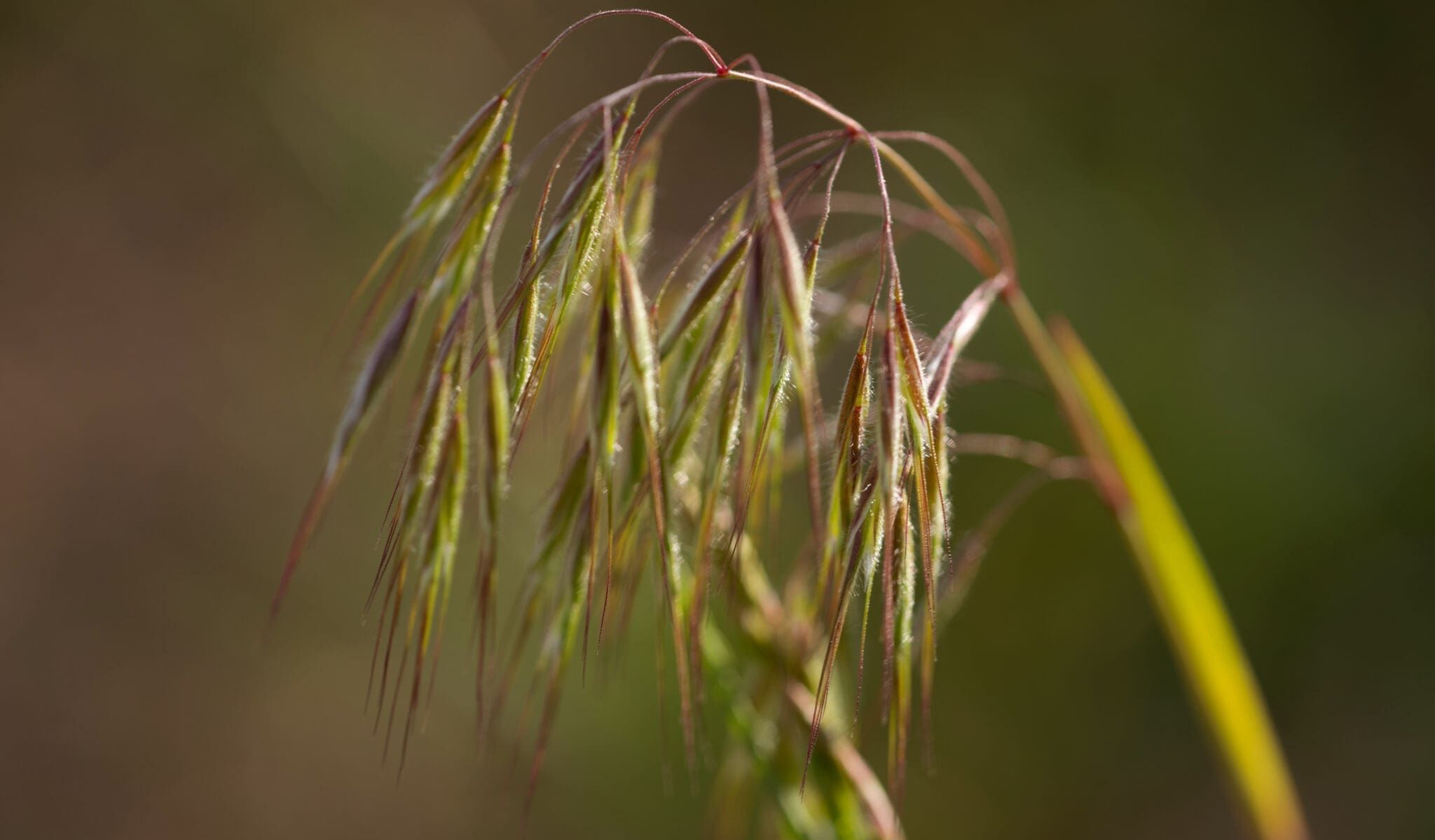Cheatgrass (Bromus tectorum) is well named. The invasive species—also known as downy brome—overwhelms native grass species, reducing wildlife habitat and livestock forage; increases the risk of wildfires in Western ecosystems; and is dangerous, even deadly, to dogs when its sharp, barbed seeds, called awns, enter the skin, typically through paws, ears and nose.
Cheatgrass usually appears early in the year soon after snow melts. It grows rapidly, producing a nodding head that droops with the weight of seeds. When they drop or are brushed against, they cling to socks and dog fur. Once trapped in a dog’s fur, there’s no place for the seed to go but in—and that’s when the trouble starts.
How Cheatgrass Harms Dogs
If they’re not removed, cheatgrass seeds burrow beneath skin, often entering at the toes or ears. They can also be inhaled into the nose or throat. They make their way through skin layers and can end up anywhere in the body: lungs, chest cavity, spinal column, eyes, muscles, and other areas. They can lodge in tissues and cause abscesses, inflammation, infections, and breathing difficulty from a buildup of fluid. Some dogs die if the problem isn’t discovered in time. In some cases, canine patients who died of peritonitis were later necropsied and found to have grass seeds in the abdominal cavity.
Most at risk are hunting, hiking, and farm or ranch dogs, who can encounter cheatgrass awns in grasslands, pine forests, and pastures. Seeds may be more likely to glom onto dogs with furnishings such spaniels, setters, and some retrievers. Doodles and other curly- or wire-coated dogs are also cheatgrass magnets.
Take your dog to the veterinarian if you can’t find any reason for violent headshaking or sneezing, ear scratching, or paw chewing. Development of a hematoma or abscess may be the least of your worries. Depending on where grass awns migrate, the extent of the infection or injury, and whether exploratory surgery or hospitalization is required, an encounter with cheatgrass can be an expensive proposition.
Signs that an awn may have migrated beneath skin or into tissues include little bubbly blisters between toes, unexplained gagging or coughing, increased respiratory rate or panting for no reason, bloody discharge from the nose, or excessive licking of a particular area. After sedation, your veterinarian can use a scope to examine ears, nose and throat and remove awns with long, narrow alligator forceps. Radiographs can indicate the presence of fluid in the chest cavity or lungs.
Bad Seeds
Other grasses with awns that can be harmful to dogs include Canada wild rye, foxtails, and needlegrasses:
- Canada wild rye is often found in seed mixes because it produces ground cover quickly. Avoid purchasing seed mixes that contain it.
- Many species of grass create seedpods that resemble fluffy foxtails, hence the name. Like cheatgrass awns, they can burrow beneath the skin. To find out more, see “Symptoms and Treatment of Foxtail Invasions in Dogs.”
- Needlegrasses (members of the genus Stipa) produce barbed seeds that are difficult to remove once in a pet’s skin or tissues.
The website www.meanseeds.com was created by dog lovers to provide information on hazardous grass awns.
What To Do
Dealing with cheatgrass is an instance of an ounce of prevention being more than worth a pound of cure. Any time your dog has been outdoors where cheatgrass is present, do a thorough body check after you return home.
Grooming the entire body is key. Brush or comb fur thoroughly, getting down to the skin for a good look, especially if you have a double-coated breed. Keep hair trimmed, especially on paws, so cheatgrass awns are less likely to become trapped in it. You may also consider having your dog wear booties in cheatgrass areas.
Push gently up beneath paw pads to cause toes to spread out so you can check between them more easily. To remove any cheatgrass you find in your dog’s paw, take a pair of needle nose pliers that you’ve sterilized with boiling water or by soaking in isopropyl alcohol for 60 seconds. Grasp the feathery end of the cheat grass—think grabbing a badminton birdie by the flared end—and pull to remove. Do this only if you can see the feathery end; otherwise take your dog to the veterinarian. Do NOT use this technique to remove awns in the nose or ears or any that have already penetrated the skin; you could injure your dog further.
Know what cheatgrass looks like and avoid areas with it when possible. Go elsewhere when the plants are noticeably reddish and dry, usually early summer and into fall. This is when seeds are more easily dislodged and become embedded in fur or skin.
Cheatgrass Killer 101
Environmental groups, government agencies, farmers and ranchers, hunters and dog lovers are all interested in eradicating cheatgrass. On your own land, nontoxic, low-tech methods are hand-pulling, hoeing, or weed-whacking it early in the season before it matures and produces seed. Shallow, short, branching roots make it easy to pull. Bag plants and toss them in the trash so they don’t have a chance to germinate elsewhere. If you have goats, sheep, or horses, intensive grazing from late fall through mid-May is a good form of biological control. Find out if your county or state has programs to help fight cheatgrass.
Rototill the soil and plant native grasses and plants such as sagebrush species or bluebunch wheatgrass, choosing a beardless variety without awns. It will take a few years to see results, but your efforts can make a big difference.


I’d like to find out more? I’d love to find out more details. http://www.hairstylesvip.com
Please provide me with more details on the topic http://www.ifashionstyles.com
Your articles are extremely helpful to me. May I ask for more information? http://www.ifashionstyles.com